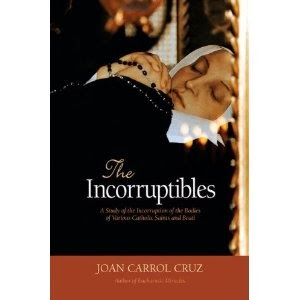When I first found out that there were some saints called “incorruptible” because their bodies never decomposed, I was skeptical. Everyone knows that gross things happen to dead things. I grew up a farm girl, and I’ve seen it lots.
 In my journey to the Catholic Church, though, I had more important things to think about than whether or not some saints’ bodies weren’t decaying, so I didn’t give the issue much thought. Recently, the incorruptibles came up in a discussion with some friends, and they passed a book on to me to read.
In my journey to the Catholic Church, though, I had more important things to think about than whether or not some saints’ bodies weren’t decaying, so I didn’t give the issue much thought. Recently, the incorruptibles came up in a discussion with some friends, and they passed a book on to me to read.
It took me a little while to pick up the book. It is, after all, a gruesome topic, and not one I wanted to tackle just before bed or for five minutes between loads of laundry. Yet it sat there waiting for me, and so one lazy Sunday afternoon, while Sunshine napped, I dove into the introduction of The Incorruptibles: A Study of the Incorruption of the Bodies of Various Catholic Saints and Beati, by Joan Carroll Cruz.
The Incorruptibles overview
The intro talked about how bodily decay has been prevented in history through embalming and natural means like dry heat. These scientific details were needed to show that what happened to the incorruptibles was different. And this was what interested me—what science could not explain.
Cruz carefully described how embalming doesn’t perfectly preserve a body, yet many saint’s bodies have been found, weeks, months, even years after their death, looking as good as if they’d just died yesterday. We could think it a hoax—but not when it happened to so many people (Cruz lists 102 and acknowledges that this isn’t a complete list) and not when it was witnessed by so many, from laypeople to church people to doctors and scientists.
The question that plagued me, as I thought about the incorruptibles, was “why?” Why would it matter to God to keep the bodies of some of His servants so perfectly preserved? Some of His miracles were obvious—water to wine in Cana and the feeding of the five thousand from a few loaves foreshadow the Eucharist, healing showed His compassion for people, calming the sea showed His power over creation. But dead bodies looking good for years after, so that we can all gawk at them? What’s the point?
One Incorruptible Saint
One of the stories I found amazing was that of St. Francis Xavier. He died while on a missionary journey to China, and was buried quickly there. His body was packed with lime to hasten decay, then squished into a too-short grave, and then moved five months later from China to India. Despite all that, the saint’s body didn’t decay, and skeptics suggested it had been embalmed.
In India, the chief medical authority examined St. Xavier’s body and declared “the limbs and other parts of the body were entire and clothed in their flesh in such a way that, according to the laws of medicine, they could not possibly have been preserved by any natural or artificial means, seeing that Father Francis had been dead and buried for about a year and a half” (Cruz). One hundred forty-two years after St. Francis Xavier died, others examined his body again and found “the body has all the appearance of being that of a living man.”
What We Can Learn from the Incorruptibles
To me, the incorruptibles demonstrate God’s power over nature again; even natural laws we all take for granted have to obey God. They also demonstrate God’s power over death; though death is inevitable, there is something more. The back cover of the book gives more answers: “The Incorruptibles are a consoling sign of Christ’s victory over death, a confirmation of the dogma of the Resurrection of the Body, a sign that the saints are still with us in the Mythical Body of Christ…”

No Responses Yet